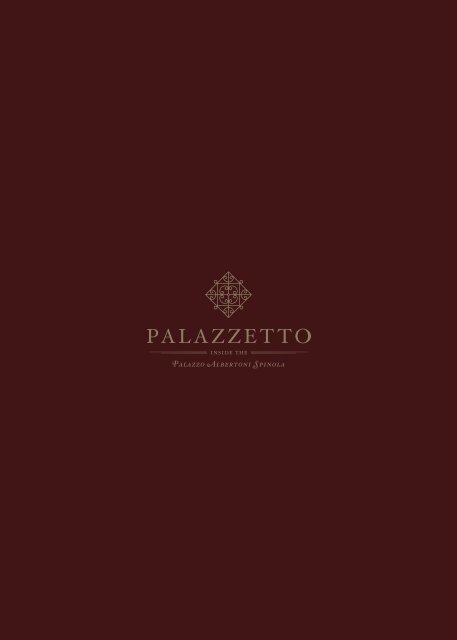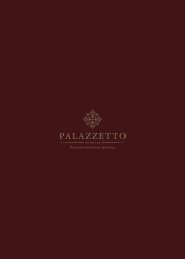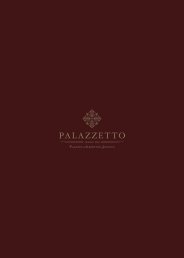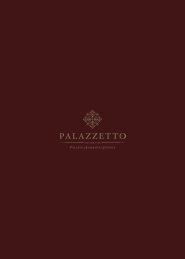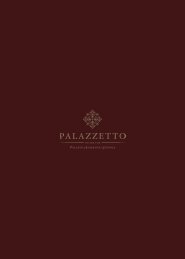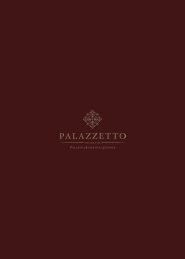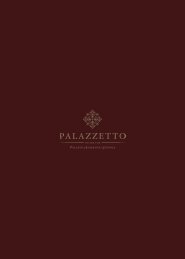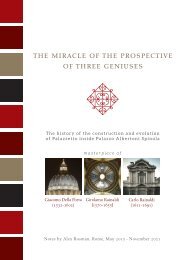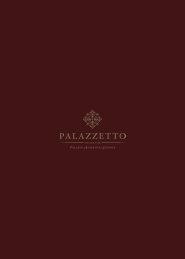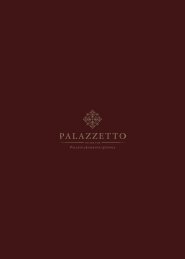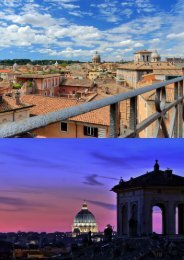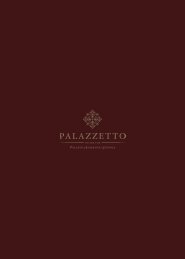You also want an ePaper? Increase the reach of your titles
YUMPU automatically turns print PDFs into web optimized ePapers that Google loves.
- 1 -
<strong>The</strong> value of an<br />
Iconic Asset<br />
INDEX<br />
Index<br />
Introduction<br />
Economic contribution<br />
Overall social value<br />
Economic and social value of the Colosseum<br />
Economic contribution 1.4 EUR/BN<br />
Total economic contribution<br />
Indirect use value 0.4 EUR/BN<br />
Social asset value (76.8 EUR/BN)<br />
<strong>The</strong> economic and social value<br />
Appendix - <strong>The</strong> <strong>Monument</strong> of the Great Perspective by Giacomo Della Porta<br />
About<br />
Giacomo Della Porta<br />
<strong>The</strong> Dome<br />
<strong>The</strong> Discovery of 2021<br />
2<br />
3<br />
4<br />
7<br />
9<br />
11<br />
17<br />
18<br />
19<br />
23<br />
24<br />
25<br />
26<br />
28<br />
30<br />
A New National Cultural Heritage<br />
<strong>The</strong> Metaverse Project 34<br />
33
<strong>The</strong> value of an<br />
Iconic Asset<br />
INTRODUCTION<br />
<strong>The</strong> Flavian Amphitheater, known as the Colosseum<br />
because of a colossal statue standing nearby, is<br />
Rome's most famous landmark and one of the New<br />
Seven Wonders of the World.<br />
In addition, it is the largest amphitheater in the<br />
world and the most visited monument in Italy. In<br />
2019 alone, more than 7 million people from all over<br />
the world visited the Colosseum.<br />
<strong>The</strong>refore, the Colosseum certainly represents a<br />
source of substantial value for Italy. In this report we<br />
examine, analyze and quantify the economic and<br />
social value of the Colosseum.
<strong>The</strong> value of an<br />
Iconic Asset<br />
ECONOMIC CONTRIBUTION<br />
<strong>The</strong> main economic contribution of the Colosseum is<br />
related to its effective use.<br />
By effective use we mean both direct and indirect<br />
use.<br />
Regarding direct use value, we estimated that the<br />
Colosseum contributes about 63.3 million euros per<br />
year in total direct value added.<br />
Value added measures the value of output (i.e., goods<br />
and services) generated by the entity's factors of<br />
production (i.e., labor and capital).<br />
In addition, the Colosseum also produces indirect<br />
effects through its supply chains in other sectors as a<br />
result of business-to-business transactions and<br />
induced effects as a result of increased householdto-business<br />
activity.
<strong>The</strong> value of an<br />
Iconic Asset<br />
ECONOMIC CONTRIBUTION<br />
Considering direct, indirect and induced effects, the<br />
Colosseum contributes 100.8 million euros of added<br />
value to the Italian economy each year and supports<br />
1,217 full-time equivalent jobs.<br />
In addition to direct spending on visiting the<br />
Colosseum, it contributes to tourism in a broader<br />
way, attracting tourists to Rome and Italy who<br />
otherwise would not have gone there.
<strong>The</strong> value of an<br />
Iconic Asset<br />
ECONOMIC CONTRIBUTION<br />
<strong>The</strong> Colosseum contributes about 1,191 euros/mln in<br />
annual spending by visitors to Rome, generating<br />
about 1,290 euros/mln in direct, indirect and<br />
induced added value.<br />
Italian residents also place considerable value on the<br />
non-use value of the Colosseum (intangible social<br />
value or existence value). This is manifested when an<br />
individual is willing to pay for the Colosseum even<br />
if he or she does not make direct use of it, does<br />
not benefit from it even indirectly, and does not<br />
anticipate future use for himself or herself or others.<br />
90% residents of Italy consider the Colosseum to be<br />
the most important Italian symbol and cultural<br />
attraction in Italy.
<strong>The</strong> value of an<br />
Iconic Asset<br />
OVERALL SOCIAL VALUE<br />
Total social value<br />
76.8 billion<br />
1.1 EUR/bn<br />
Transaction Value<br />
75.7 EUR/bn<br />
Existence Value
<strong>The</strong> value of an<br />
Iconic Asset<br />
OVERALL SOCIAL VALUE<br />
Several opportunities to increase the economic and<br />
social value of the Colosseum. <strong>The</strong>se may include, for<br />
example, its support for Italian culture, its<br />
educational activities, and investments in digital<br />
technology.
<strong>The</strong> value of an<br />
Iconic Asset<br />
ECONOMIC AND SOCIAL VALUE<br />
OF THE COLOSSEUM<br />
Economic value<br />
Amount of wealth (tangible and intangible) that<br />
such wealth generates for society.<br />
How is wealth generated?<br />
Tourist attraction —> Contribute to direct<br />
employment and also to the local economy<br />
To people passing through and enjoying the<br />
landscape<br />
Housing comfort, as people derive well-being<br />
from living near it.<br />
Market transactions related to living comfort,<br />
on the other hand, can be observed, albeit<br />
indirectly, in the housing market
<strong>The</strong> value of an<br />
Iconic Asset<br />
ECONOMIC AND SOCIAL VALUE<br />
OF THE COLOSSEUM<br />
Actual use value<br />
Visitation value and from the existence value of the<br />
Coliseum.<br />
Value of the visitor<br />
Market or social value given by transaction value-the<br />
proceeds from the sale of goods and services.<br />
Existence value<br />
Non-use value.
<strong>The</strong> value of an<br />
Iconic Asset<br />
ECONOMIC CONTRIBUTION<br />
1.4 EUR/BN<br />
<strong>The</strong> economic contribution of the Colosseum<br />
includes its added value as well as the tourism it<br />
generates and from employment in the Italian<br />
economy.<br />
<strong>The</strong> total direct use value is mainly from the induced<br />
tourism contribution (93%).<br />
Value added measures the value of goods and<br />
services produced by an entity's factors of production<br />
(i.e., labor and capital) as reflected in the income of<br />
those factors of production (wages and gross<br />
operating surplus).
<strong>The</strong> value of an<br />
Iconic Asset<br />
ECONOMIC CONTRIBUTION<br />
1.4 EUR/BN<br />
<strong>The</strong> sum of the value added by all entities in the<br />
economy = GDP<br />
<strong>The</strong> first element of its value is therefore equal to the<br />
direct added value generated by its operation,<br />
management and maintenance.<br />
<strong>The</strong> first element of the Colosseum's economic<br />
contribution is actually given by the direct cash<br />
flows produced by its specific exploitation<br />
(Revenue generated mainly from admission tickets).<br />
Indirect effects concern intermediate consumption<br />
for the production of goods and services in the<br />
tourism sector.
<strong>The</strong> value of an<br />
Iconic Asset<br />
ECONOMIC CONTRIBUTION<br />
1.4 EUR/BN<br />
Induced effects concern employee expenditures<br />
resulting from wages paid by companies in direct<br />
contact with tourists.<br />
<strong>The</strong>y also include the consumption of companies that<br />
benefited directly or indirectly from the initial<br />
spending in the tourism sector.<br />
<strong>The</strong> methodology for assessing indirect and induced<br />
economic impacts generated by direct effects is<br />
carried out in an input-output (IO) framework,<br />
relying on the key contribution of tourism satellite<br />
accounts (TSAs), which provide the most accurate<br />
and reliable measure of tourism's role in an economy.
<strong>The</strong> value of an<br />
Iconic Asset<br />
ECONOMIC CONTRIBUTION<br />
1.4 EUR/BN<br />
<strong>The</strong> direct cash flows produced by the operation of<br />
the Colosseum correspond to about 75.3 million<br />
euros in direct visitor tourism spending in 2019.
<strong>The</strong> value of an<br />
Iconic Asset<br />
ECONOMIC CONTRIBUTION<br />
1.4 EUR/BN<br />
This revenue comes mainly from spending on<br />
entrance fees paid by tourists entering the<br />
Colosseum and on additional services related to the<br />
visit, such as guided tours, the purchase of audio<br />
guides, ticket presale fees, and royalties on gadgets<br />
sold in the bookshops.<br />
Overall, the operation of the Colosseum generates<br />
about 63.3 million euros in added value.<br />
Our estimate of the indirect and induced<br />
contribution is 37.5 euros/mln of value added.<br />
Thus, the total annual contribution is the sum of<br />
direct, indirect and induced effects.<br />
<strong>The</strong> operation of the Colosseum generates 100.8<br />
euros/mln of total value added to the Italian<br />
economy.
<strong>The</strong> value of an<br />
Iconic Asset<br />
ECONOMIC CONTRIBUTION<br />
1.4 EUR/BN<br />
<strong>The</strong> Colosseum was responsible for about EUR1,190.9<br />
million in tourism spending in 2019.<br />
We estimate that tourism spending attributed to the<br />
Colosseum contributes about EUR696.9/mln of direct<br />
value added and about EUR592.7/mln of indirect and<br />
induced value added to the Italian economy.<br />
<strong>The</strong>refore, our estimate of total value added is<br />
about EUR 1,289.6/mln.
<strong>The</strong> value of an<br />
Iconic Asset<br />
TOTAL ECONOMIC CONTRIBUTION<br />
<strong>The</strong> total economic contribution of the Colosseum<br />
includes the direct, indirect and induced effects of<br />
tourism spending related to both direct operation<br />
and induced tourism.<br />
It is estimated that the Colosseum generates a total<br />
of about 1,266 million euros in tourist spending and<br />
1,000 million euros in induced spending and 1,390<br />
euros/million euros of added value to the Italian<br />
economy.<br />
In addition, the Colosseum is estimated to support<br />
the employment of about 42,700 people on a fulltime<br />
equivalent (FTE) basis.
<strong>The</strong> value of an<br />
Iconic Asset<br />
INDIRECT USE VALUE<br />
0.4 EUR/BN<br />
Indirect use value is estimated in terms of living<br />
comfort as people derive well-being from living near<br />
it.<br />
<strong>The</strong> hedonic price method is a surrogate market<br />
technique focusing on markets for private goods and<br />
services whose price can be influenced by the<br />
cultural asset of interest. <strong>The</strong> hedonic pricing<br />
method aims to estimate the implicit price of a set of<br />
features by observing the actual markets in which<br />
they are actually traded.<br />
In order to find the demand function related to the<br />
attribute of interest, it is first necessary to define the<br />
market good (e.g., housing) and the attributes of the<br />
market good (e.g., size, number of rooms, proximity<br />
to commercial activities and recreational areas, etc.)<br />
Our estimate of the indirect use of the Colosseum<br />
related to living comfort is 406.1 euros/mln.
<strong>The</strong> value of an<br />
Iconic Asset<br />
SOCIAL ASSET VALUE<br />
(76.8 EUR/BN)<br />
<strong>The</strong> social asset value of the Coliseum includes<br />
transaction value and existence value (non-use<br />
value).<br />
<strong>The</strong> social asset value is mainly given by the non-use<br />
value (98%).<br />
76.8 EUR/bn<br />
1.1 EUR/bn<br />
Transaction Value<br />
75.7 EUR/bn<br />
Existence Value
<strong>The</strong> value of an<br />
Iconic Asset<br />
SOCIAL ASSET VALUE<br />
(76.8 EUR/BN)<br />
Overall social value<br />
=<br />
Existence value<br />
+<br />
Value of visitors *<br />
*calculated using market or social value = transaction valuethe<br />
proceeds from the sale of goods and services.
<strong>The</strong> value of an<br />
Iconic Asset<br />
SOCIAL ASSET VALUE<br />
(76.8 EUR/BN)<br />
76.8 EUR/bn<br />
1.1 EUR/bn<br />
Transaction Value<br />
75.7 EUR/bn<br />
Existence Value<br />
Every year, more than 7 million<br />
people from all over the world<br />
visit the Colosseum.<br />
<strong>The</strong>se people pay an average of<br />
10.2 euros for their visit. <strong>The</strong><br />
total transaction value for the<br />
Colosseum is about 75.3<br />
euros/million.<br />
People may evaluate the<br />
Colosseum as "iconic" or<br />
"symbolic," or they may<br />
evaluate the Colosseum's<br />
contribution to culture and<br />
learning.
<strong>The</strong> value of an<br />
Iconic Asset<br />
SOCIAL ASSET VALUE<br />
(76.8 EUR/BN)<br />
Total social asset value<br />
<strong>The</strong> Colosseum has a total social asset value with a<br />
100-year NPV5 of 76.8 euros/billion.<br />
Table 10 provides a detailed summary of the<br />
estimated annual and asset values of the Colosseum's<br />
total social asset value.
<strong>The</strong> value of an<br />
Iconic Asset<br />
THE ECONOMIC AND SOCIAL VALUE<br />
Direct use of the Colosseum generates a total of<br />
1,390.5 million euros per year in value added to the<br />
Italian economy.<br />
<strong>The</strong> indirect use value of the Colosseum, in terms of<br />
living comfort for residents, is 406 euros/mln.<br />
<strong>The</strong> total social asset value of the Colosseum,<br />
including transaction and existence value, is 76.8<br />
euro/mln.<br />
About 98 percent of the value of the Colosseum's<br />
social asset is existence value, also known as cultural<br />
or iconic value (75.2 euros/mln).
Appendix<br />
<strong>The</strong> <strong>Monument</strong> of the<br />
Great Perspective by<br />
Giacomo Della Porta
<strong>The</strong> <strong>Monument</strong> of the<br />
Great Perspective by<br />
Giacomo Della Porta<br />
ABOUT<br />
Palazzetto Inside Palazzo Albertoni Spinola is both<br />
an architectural <strong>Monument</strong> with magnificent views<br />
and amenities.<br />
<strong>The</strong> building was constructed by the geniuses of the<br />
Italian Renaissance Giacomo Della Porta (1532-<br />
1602) who has previously worked on St. Peter’s<br />
Basilica as well as Girolamo Rainaldi (1570-1655) who<br />
successfully completed several of Michelangelo’s<br />
projects.<br />
Located in the center of Rome, which was declared a<br />
World Heritage site by the Unesco, the compound is<br />
protected by the Italian Government.
<strong>The</strong> <strong>Monument</strong> of the<br />
Great Perspective by<br />
Giacomo Della Porta<br />
A NEW NATIONAL CULTURAL<br />
HERITAGE<br />
<strong>The</strong> Perspective of Palazzetto Inside Palazzo<br />
Albertoni Spinola is an architectural masterpiece<br />
the result of Renaissance master and architect<br />
Giacomo Della Porta, which became part of the<br />
Italian Cultural Heritage in May 16, 2022.
<strong>The</strong> <strong>Monument</strong> of the<br />
Great Perspective by<br />
Giacomo Della Porta<br />
A NEW NATIONAL CULTURAL<br />
HERITAGE<br />
Indeed, the Great Perspective has just became a<br />
National treasure, an official National Cultural<br />
Heritage by the Italian government, on the same<br />
level as other cultural masterpieces such as the<br />
Galleria Spada made by one of the greatest architect<br />
in the history, Francesco Borromini.
<strong>The</strong> <strong>Monument</strong> of the<br />
Great Perspective by<br />
Giacomo Della Porta<br />
GIACOMO DELLA PORTA<br />
All the greatest historians and biographers talk about<br />
the construction of the Palace. In particular Giovanni<br />
Baglione mentions it in his most famous work Le<br />
Vite dei pittori, scultori, et architetti.<br />
Giacomo Della Porta was one of the most important<br />
architects of the Renaissance. Mistakenly, for a long<br />
time, he was considered exclusively the "master of<br />
fountains", given the large number of projects he<br />
carried out in this field during his career.<br />
Giacomo Della Porta
<strong>The</strong> <strong>Monument</strong> of the<br />
Great Perspective by<br />
Giacomo Della Porta<br />
GIACOMO DELLA PORTA<br />
However, it would be reductive to relegate Giacomo<br />
Della Porta exclusively to this task. <strong>The</strong> Lombard<br />
architect was much more than that: he was a pupil<br />
of the greatest artist of all time Michelangelo<br />
Buonarroti.<br />
Working in close contact with Michelangelo, Della<br />
Porta made his own all the wisdom of the Master, day<br />
after day, pouring and paying homage to<br />
Michelangelo's genius in his architectural projects,<br />
especially in Palazzo Albertoni Spinola.
<strong>The</strong> <strong>Monument</strong> of the<br />
Great Perspective by<br />
Giacomo Della Porta<br />
THE DOME<br />
As papal architect he was in charge of the Fabbrica<br />
della Sapienza and from 1573 of the masterpiece of<br />
the creative spirit of man and at the same time the<br />
symbol of the Church of Rome: the St. Peter’s<br />
Dome.<br />
<strong>The</strong> Dome of St. Peter
<strong>The</strong> <strong>Monument</strong> of the<br />
Great Perspective by<br />
Giacomo Della Porta<br />
THE DOME<br />
Based on what is historically known, Della Porta<br />
developed the rest of the unfinished structure after<br />
Michelangelo's death in 1564. He was also in charge<br />
of redesigning the overall project, because the<br />
original version would have most likely collapsed<br />
under the excessive weight of the Dome.<br />
Della Porta and the architect Fontana not only made<br />
a significant modification to the curvature of the<br />
Dome with respect to the presumed project of<br />
Buonarroti, making it closer to the model of<br />
Brunelleschi, but they inserted a series of chains in<br />
the stonework to contain the transversal thrusts<br />
exerted by the vault and used high quality materials,<br />
hinging the travertine slabs with molten lead.
<strong>The</strong> <strong>Monument</strong> of the<br />
Great Perspective by<br />
Giacomo Della Porta<br />
THE DISCOVERY OF 2021<br />
On May 22, during a guided tour of St. Peter's<br />
Basilica, the architect Alex Rosman paused to reflect<br />
on the role and figure of Giacomo Della Porta as<br />
Michelangelo Buonarroti's successor in the<br />
completion of the famous Cupola, which provided<br />
suggestion that the construction of Piazza Campitelli<br />
could be so complex that it could "hide" urban<br />
planning and architectural techniques worthy of<br />
deeper analysis.<br />
<strong>The</strong> Great Perspective
<strong>The</strong> <strong>Monument</strong> of the<br />
Great Perspective by<br />
Giacomo Della Porta<br />
THE DISCOVERY OF 2021<br />
But immediately the next day, admiring the view<br />
from the front door of the rear building, the<br />
Palazzetto, Alex realized that the door of the large<br />
building framed the door of the church of Santa<br />
Maria in Campitelli perfectly to the millimeter.<br />
<strong>The</strong> perspective, through the androne, the entrance<br />
gallery and the door of the body of the great<br />
building, is perfect, while from the latter, the front<br />
view falls on the left side of the church itself, and not<br />
on the entrance.<br />
Plan of the Palace with the axes of the views highlighted among the<br />
building elements consisting of the palace on Campitelli Square, the<br />
church of S. Maria Campitelli, and the small palace on Capizucchi Alley
<strong>The</strong> <strong>Monument</strong> of the<br />
Great Perspective by<br />
Giacomo Della Porta<br />
THE DISCOVERY OF 2021<br />
<strong>The</strong>n, he was succeeded by Girolamo Rainaldi, who<br />
had long collaborated with him. Rainaldi was<br />
responsible for aligning the facade of the building<br />
(completed around 1616) with the plan of the square.<br />
Meanwhile, the house of Blessed Ludovica was<br />
converted into a small church. <strong>The</strong> building was then<br />
rebuilt and enlarged on September 29, 1600, on the<br />
commission of Pope Alexander VII.<br />
<strong>The</strong> work was entrusted to Carlo Rainaldi, Girolamo's<br />
son, who, knowing full well the intention of the two<br />
masters, built the great portal exactly where the<br />
portal to the house of the Blessed was located, with<br />
millimeter precision.
<strong>The</strong> <strong>Monument</strong> of the<br />
Great Perspective by<br />
Giacomo Della Porta<br />
THE METAVERSE PROJECT<br />
What's more, Palazzo Albertoni Spinola and<br />
Giacomo Della Porta's Perspective monument will<br />
also be replicated in the metaverse, in the Spatial<br />
Web3 platform metaverse through Exclusible<br />
This is an absolutely innovative operation, never done<br />
before, where a cultural asset, a private monument<br />
will become navigable via mobile, PC and VR.<br />
However, the goal is not just to recreate not only the<br />
environments of the brick work but also the<br />
masterpiece of Giacomo Della Porta's perspective in<br />
all its magic.
- 124 -


